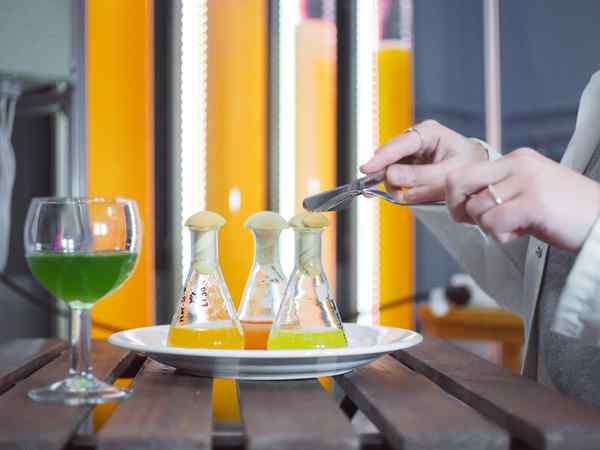Images of climate innovation
Food for the future
Join us in a future feast of algal products. Our salt-loving, brightly coloured algae, found in salt lakes and coastal waters around the globe, grow rapidly in our columns of non-potable brine bubbled with CO2 from flue-gas. These algae are a renewable and sustainable source of food, provide health products that protect us against sun-damage and treat diseases, and novel biofuel for the future, saving fresh water and cutting CO2 emissions.

Algae are known to convert CO2 and sunlight into chemical energy five times faster than crops grown in soil. Our Dunaliella salina alga produces up to 80% of its mass in saltwater as the novel biofuel, glycerol, but since fuel-only algal systems are expensive, additional revenues are required.
Using novel microalgal biorefinery technology, we have worked out how to cultivate this alga to produce compounds of great interest in pharmaceutical, cosmetic, nutraceutical, and other applications, with huge savings in freshwater as well as cutting CO2 emissions and freeing up arable land for other purposes. Hyperaccumulator strains grown in saltwater under low energy red light, switch on production of rare carotenoids, proteins, lipids, and glycerol, and reduce processing costs by several orders of magnitude.
Carotenoids that are costly to synthesise chemically can now be produced at scale to deliver much-needed effective treatments to combat common eye disease and blindness, which affects millions of people, and to treat life-changing conditions such as atherosclerosis, which is the underlying cause of ~ 50% of all deaths in westernized society. Colourless carotenoids, also produced by Dunaliella, can be incorporated in skin-care products and nutricosmetics as natural protectants against solar damage caused by UV light.
After their extraction, the remaining proteins of Dunaliella offer an excellent essential amino acid profile, well-suited to meet human nutritional requirements and to support healthy lifestyles. Concurrently, demand for glycerol as a biofuel, which combusts with extremely low exhaust emissions and considerable carbon savings, is mounting. Delivering solutions for large-scale production of Dunaliella and turning every part of the alga into something useful will enable us to valorise this algal cell factory to deliver substantial societal and economic benefits, and savings of up to 90% greenhouse gas emissions and other environmental impacts compared to the current state-of-the-art.
Entrant: Patricia Harvey , University of Greenwich
Copyright: Yixing Sui
Funding: Interreg 2 Seas programme 2014-2020 co-funded by the European Regional Development Fund under subsidy contract No ValgOrize 2S05017: Valorizing algae for a better taste; EU KBBE.2013.3.2-02 programme The CO2 Microalgae Biorefinery: D-Factory: 368 613870; Algae-UK BiV with Quadrise Fuels: Microalgal glycerol for use in bioenergy applications; UKRI Science and Technology Facilities Council (STFC) Food Network+ (SFN) Identification of umami taste markers in microalgae-based novel food.
Collaborators: Prof P. J. Harvey, Dr Y Xu, Dr. Y Sui (University of Greenwich)